Introduction
COVID-19 represents an unprecedented emergency and grave societal threat, during this period protecting public health is the first priority. However, efforts were also made to recognize and mitigate the negative impacts of the pandemic on livestock sector which is a key contributor to food security, nutrition and livelihoods. Although, deficiency in feed and fodder is identified as one of the major constraints in achieving desired level of livestock productivity. Further, availability and quality of feed and fodder is increasingly becoming a challenge due to rapidly shrinking land and natural resources and hardly 4.5% of the cropped area is utilized to grow fodder crops. Also in India, nearly 85% of the farmers are small and marginal and in this resource poor agriculture system farmers produce only food crops to meet out their household needs or to earn some money from the produce. In this system livestock are reared only on the available crop residues and are devoid of other nutrient supplements, green fodder etc. for their desirable growth. But for the optimum growth and development of the animal, nutritional management is very important and green fodder plays an important role in nutritional management. Cultivation of high quality green fodder with scientific crop rotation may be a good solution for this consideration for large commercial enterprises because green fodder provides a good amount of crude protein (CP) and total digestible nutrients (TDN) to livestock.
However, in a commercial livestock rearing there is a long-standing issue of land availability for the cultivation of green fodder and recently the issues of labour scarcity, maintaining proper hygiene and following the Covid-19 guidelines for the safety of farm animals and human beings have emerged as a challenging task. To address these issues on livestock farm it is very important to know about important forage crops, their production technology, important fodder trees, other unconventional fodder sources and feeding of animals with maintaining a safe distance by following all the precautionary measures of Covid-19. Looking to the above facts this article is written for the easy and timely management of forage resources for livestock during COVID – 19.
Forage Crops
The crops which primarily grown for livestock feed, to be either harvested as green fodder, for hay or for silage or harvested by grazing animals are known as forage crops. The cultivated fodder crops can be broadly grouped as – cereals fodder and legume fodder.
Cereal fodders: Maize, Sorghum, Pearl millet, oats, etc.
Legume fodders: Cowpea, Cluster bean, Berseem, Lucerne, etc.
Production technology of forage crops
The following points should be considered while growing the forage crop:
- Select seeds of high yielding varieties or hybrids.
- Grow the forage crops by following all the agronomic practices.
- Grow the crop in a suitable cropping cycle/system.
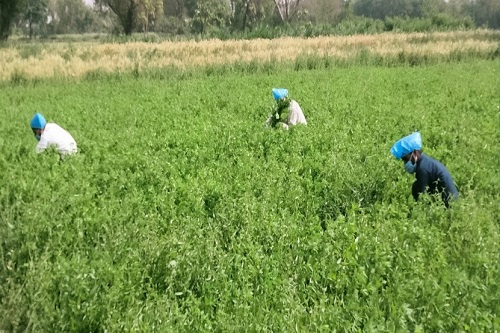
- To maintain soil productivity and fodder quality grow both grass and leguminous crop interchangeably or mixed.
- Grow perennial fodder crop in 15-20 percent of cultivable land for throughout the green fodder production.
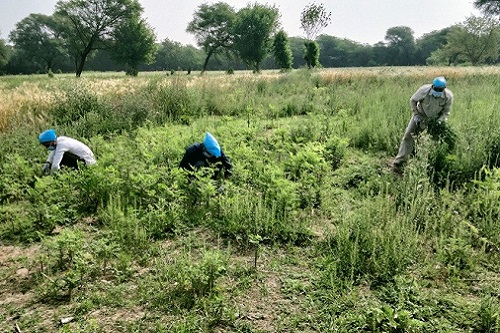
- Plant some fodder trees on the boundary of the field, which can maintain the availability of fodder in adverse conditions.
- To produce high quality and nutrient rich fodder, it should be harvested at right stage.
- To prevent wastage of feed, give chaffed green fodder to livestock.
The fodder crops can be grown and harvested by maintaining the safe social distancing between the labours of the farm and by wearing of all the protective items like mask, gloves etc. to prevent the spread of Covid-19 virus.
Fodder Tress
Tress producing shoots or sprouts of tender twigs and stem from woody parts with their leaves browsed by domestic and wild animals to varying extend are known as fodder trees. Fodder trees have good potential for supplying the quality fodder with good amount of crude protein for goats throughout the year. In case of no browsing, lopping provided by the farmer is also form a good fodder source for goats. Production of cultivated green fodder is a time bound operation due to seasonality of fodder crops, availability of irrigation water, timely availability of good quality seed and other inputs etc. Therefore, in the situation when no cultivated green fodder is available fodder trees provide a good quality fodder for the growth and maintenance of goats. Fodder trees can be grown either in combination with agricultural crops under agroforestry system or on separate land usually not fit for other crops. Tree fodder can also be used as a very good source of feed for small ruminants especially during Covid-19 period when there is huge labour scarcity, it required a very few farm labours for livestock feeding.
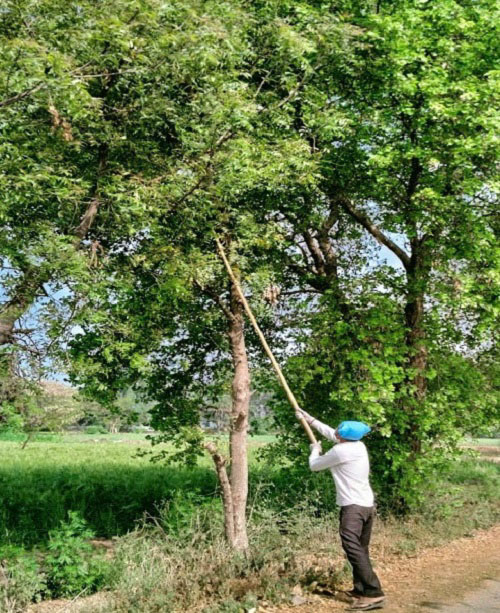
Azolla cultivation
Azolla is a very small free floating fern that spread quickly on water bodies. Most commonly occurring species of azolla in India are Azolla pinnata and Azolla microphylla. It is considered as the most economic and nutritive feed supplement for animals. On dry weight basis it contains 20-22% Crude protein, 14-15% Crude fibre, 3.5-4.5% ether extract, 1.2-1.6% calcium, 0.1-0.3% phosphorus, 1.7-2.5% potassium etc. It also contains trace elements like Cu, Zn, Fe, Mn, Co etc. in sufficient quantity. Beside these nutrients it also contains vitamins, bio-active substances and bio-polymers which make it a highly efficient and effective feed for animals. Green azolla can be feed to growing goat kids and adult goats along with dry fodder. During harvesting of azolla from pond and feeding of animals by maintaining precautionary measures of Covid-19 provides nutrient rich supplements to livestock.
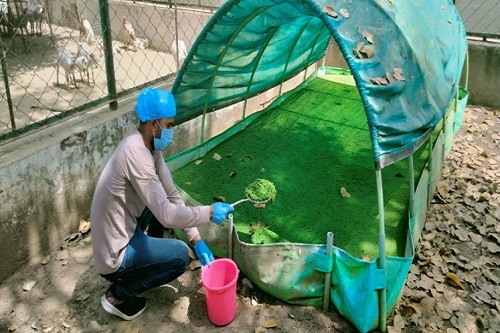
Pallet feed
The purpose of pelleting is to improve feed handling and acceptance by livestock. In pelleting process finely divided, dusty, unpalatable and difficult-to-handle feed materials are converted into larger particles by using heat, moisture and pressure. In this process all the feed ingredients are mixed together and conditioned with heat/steam to make them stick together under pressure in the pellet mill. The conditioned mixture is then mechanically forced through a die press by rollers to get the required feed pellets. Pellets in the form of larger particles are easier to handle, more palatable and give improved feeding results when compared to the non pelleted feed. Homogenous nutritional value is available to the animals by feeding pelleted feeds. Pelleted feeds have better flow ability and can easily be transported and stored. The composition of the pellets remains fixed hence no segregation and addition occurs. During the process of pelleting the workers have taken all preventive measures of corona virus. They have been asked to wear plastic cap, gloves and mask while handling feed ingredients and product.
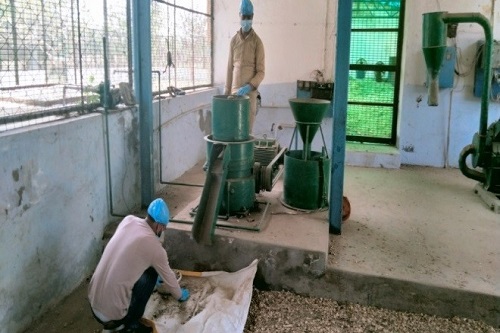
Feeding to animals
Feeding is the important component of commercial livestock farming. Better results of commercial livestock production and maximum profit mainly dependents on feeding high quality fresh, nutritious and clean feed. Along with enough regular green fodder and bhusa the goats were also provided with nutritious concentrate feed in pelleted form regularly. Feeding of the animals was done as per the schedule of feeding concentrate and green fodder. Feeders were thoroughly cleaned every day and freshly harvested green fodder and stored hay (bhusa) was put in the cleaned feeder. Concentrate pellet feed was also put in the feeder as per schedule. To carry out all these operations the workers were asked to clean their hands thoroughly with soap and wear gloves, mask and cap to prevent spread of Corona Virus. All the workers before entering the shed had gone under thermal screening. Clean water was also provided in properly cleaned water trough in proper hygienic condition. Water troughs and feeders were put at separate places away from one another. Along with feeding the goats were also observed for health condition every day and if there were any sick animals, then those animals were separated from main stock and treatment and feeding was done in isolation. While feeding we had taken care of not feeding any used, damp or contaminated feed. Use of proper size of feeder reduces wasting of feed. If there is any change in the food habit of goats, it should be done slowly. Sudden change should be avoided.
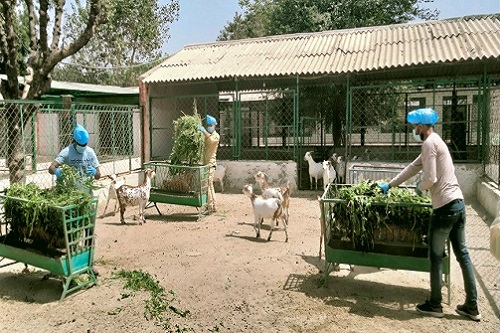
Conclusions
Livestock being biological entity need regular feed and water for maintaining their good health and productivity. All these operations need to be carried out even during pandemic like COVID-19 following all preventive measures. Cultivation of suitable green fodder in the field and its harvesting and feeding to the animals on regular basis with proper protection is essential. During the absence of field fodder crops we may go for tree fodder. Fodder trees are considered good source of supplying quality fodder with good amount of crude protein for goats throughout the year. Azolla is also considered as economical and nutritive feed supplement for livestock. Other than crude protein, crude fibre and calcium it also contains trace elements like Cu, Zn, Fe, Mn, Co etc. Pelleted feed is very much important for commercial goat farming as it reduces feed wastage up to 15-20% and improves overall nutrient use and production efficiency by 15-25 %. Thermal screening of all the farm workers and others entering the farm, bearing mask and gloves and hand sanitization during COVID-19 pandemic had prevented the farm from corona virus infections.







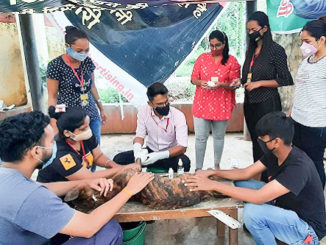


1 Trackback / Pingback